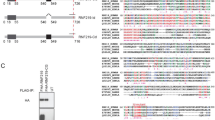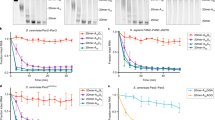Abstract
GW182-family proteins are essential for microRNA-mediated translational repression and deadenylation in animal cells. Here we show that a conserved motif in the human GW182 paralog TNRC6C interacts with the C-terminal domain of polyadenylate binding protein 1 (PABC) and present the crystal structure of the complex. Mutations at the complex interface impair mRNA deadenylation in mammalian cell extracts, suggesting that the GW182-PABC interaction contributes to microRNA-mediated gene silencing.


Similar content being viewed by others
Accession codes
References
Filipowicz, W., Bhattacharyya, S.N. & Sonenberg, N. Nat. Rev. Genet. 9, 102–114 (2008).
Eulalio, A., Huntzinger, E. & Izaurralde, E. Cell 132, 9–14 (2008).
Eulalio, A., Tritschler, F. & Izaurralde, E. RNA 15, 1433–1442 (2009).
Behm-Ansmant, I. et al. Genes Dev. 20, 1885–1898 (2006).
Till, S. et al. Nat. Struct. Mol. Biol. 14, 897–903 (2007).
Eulalio, A., Huntzinger, E. & Izaurralde, E. Nat. Struct. Mol. Biol. 15, 346–353 (2008).
Zipprich, J.T., Bhattacharyya, S., Mathys, H. & Filipowicz, W. RNA 15, 781–793 (2009).
Eulalio, A., Helms, S., Fritzsch, C., Fauser, M. & Izaurralde, E. RNA 15, 1067–1077 (2009).
Chekulaeva, M., Filipowicz, W. & Parker, R. RNA 15, 794–803 (2009).
Lazzaretti, D., Tournier, I. & Izaurralde, E. RNA 15, 1059–1066 (2009).
Höck, J. et al. EMBO Rep. 8, 1052–1060 (2007).
Landthaler, M. et al. RNA 14, 2580–2596 (2008).
Fabian, M.R. et al. Mol. Cell 35, 868–880 (2009).
Zekri, L., Huntzinger, E., Heimstadt, S. & Izaurralde, E. Mol. Cell. Biol. 29, 6220–6231 (2009).
Craig, A.W., Haghighat, A., Yu, A.T. & Sonenberg, N. Nature 392, 520–523 (1998).
Khaleghpour, K. et al. Mol. Cell 7, 205–216 (2001).
Khaleghpour, K. et al. Mol. Cell. Biol. 21, 5200–5213 (2001).
Kozlov, G. et al. EMBO J. 23, 272–281 (2004).
Roy, G. et al. Mol. Cell. Biol. 22, 3769–3782 (2002).
Baron-Benhamou, J., Gehring, N.H., Kulozik, A.E. & Hentze, M.W. Methods Mol. Biol. 257, 135–154 (2004).
Acknowledgements
We thank D. King (Howard Hughes Medical Institute Mass Spectrometry Laboratory, Univ. California Berkeley) for peptide synthesis and mass spectrometry, and C. Ralston and J. Holton (Beamlines 8.2.1 and 8.3.1, Advanced Light Source, Lawrence Berkeley National Laboratory) for assistance with X-ray data collection. We are indebted to W. Filipowicz for discussions and to members of the Doudna laboratory for critical reading of the manuscript. M.J. is supported by a Human Frontiers Science Program fellowship. M.R.F. is supported by a Terry Fox Foundation fellowship from the Canadian Cancer Society. This work was funded in part by a Canadian Institutes of Health Research grant to N.S. N.S. is an International Scholar of the Howard Hughes Medical Institute. J.A.D. is a Howard Hughes Medical Institute Investigator.
Author information
Authors and Affiliations
Contributions
M.J., M.R.F., N.S. and J.A.D. designed experiments. M.J. performed binding assays, crystallized the TNRC6C–PABC complex and determined its structure. M.R.F. performed in vitro deadenylation assays. S.M.C. assisted with X-ray data collection and structure determination. M.J. and J.A.D. wrote the manuscript.
Corresponding author
Ethics declarations
Competing interests
The authors declare no competing financial interests.
Supplementary information
Supplementary Text and Figures
Supplementary Figures 1–6, Supplementary Table 1 and Supplementary Methods (PDF 3357 kb)
Rights and permissions
About this article
Cite this article
Jinek, M., Fabian, M., Coyle, S. et al. Structural insights into the human GW182-PABC interaction in microRNA-mediated deadenylation. Nat Struct Mol Biol 17, 238–240 (2010). https://doi.org/10.1038/nsmb.1768
Received:
Accepted:
Published:
Issue Date:
DOI: https://doi.org/10.1038/nsmb.1768
- Springer Nature America, Inc.
This article is cited by
-
Multilineage polyclonal engraftment of Cal-1 gene-modified cells and in vivo selection after SHIV infection in a nonhuman primate model of AIDS
Molecular Therapy - Methods & Clinical Development (2016)
-
Towards a molecular understanding of microRNA-mediated gene silencing
Nature Reviews Genetics (2015)
-
From guide to target: molecular insights into eukaryotic RNA-interference machinery
Nature Structural & Molecular Biology (2015)
-
The complexity of miRNA-mediated repression
Cell Death & Differentiation (2015)
-
The panorama of miRNA-mediated mechanisms in mammalian cells
Cellular and Molecular Life Sciences (2014)





